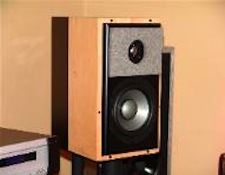It’s the time of year for saving money!
Several years back I bought a bunch of ¾” thick industrial
felt to cover my computer desktop. I wanted to kill the mid and treble
frequencies that were bouncing off my wooden desk from my nearfield speakers.
It was quite effective and I recommend it for high-end DAWs (along with a nice
hand-knotted small rug on top of the felt for a bit more damping and aesthetic
considerations.)
Naturally, as with all home projects, I had quite a bit of
felt left over. And then I read about Diffraction Be Gone, and since I had some felt that looked quite a bit like the felt that is used
to make Diffraction Be Gone speaker devices, I thought I’d try making my own.
My conclusion, after putting a set on my Skiing
Ninja-modified X-Static and X-Voce speakers, was that putting a felt panel over
the front baffle did attenuate mid and upper frequency reflections from the
front baffle. In short, the idea behind Diffraction Be Gone was sound and they
worked.
After living with my home-brew diffraction reducers for over
a year I got to wondering how different, and perhaps better, Jim Goulding’s
original “Touchstone Tweeter Surrounds”
would be, so I got a set from him.
Upon receiving the Touchstone Speaker Surrounds I compared
them with my home-brew version. The felt that Jim Goulding uses is much denser
and not as thick as my felt, also the tweeter holes were larger and due to the
felts’ thickness, had less impact on a tweeter’s dispersion pattern. In
short, the Touchstone Speaker Surround’s
material is much better than my home-brew solution.
After installing Jim’s felt pads I noticed the same
improvements in imaging and detail as with my own felt pads, but with slightly
larger listening window. Also the Touchstone Speaker Surrounds looked far nicer
than my pads and they fit better.

Given the price and minimum order requirements for
industrial felt, you could end up spending nearly as much to make your own felt
pads as you would ordering a set from Diffraction Be Gone, and as with my set,
end up with something that’s not as good.
There’s a reason that The Absolute Sound’s Robert E Greene
gave Touchstone Speaker Surrounds his Golden Ear Award in 2008. If you have a
pair of speakers that you like and they have a
hard front baffle (as most speakers do) adding a set of Touchstone Speaker
Surrounds could prove to be one of the mot cost-effective improvements you
could make to them.
It worked for me…





